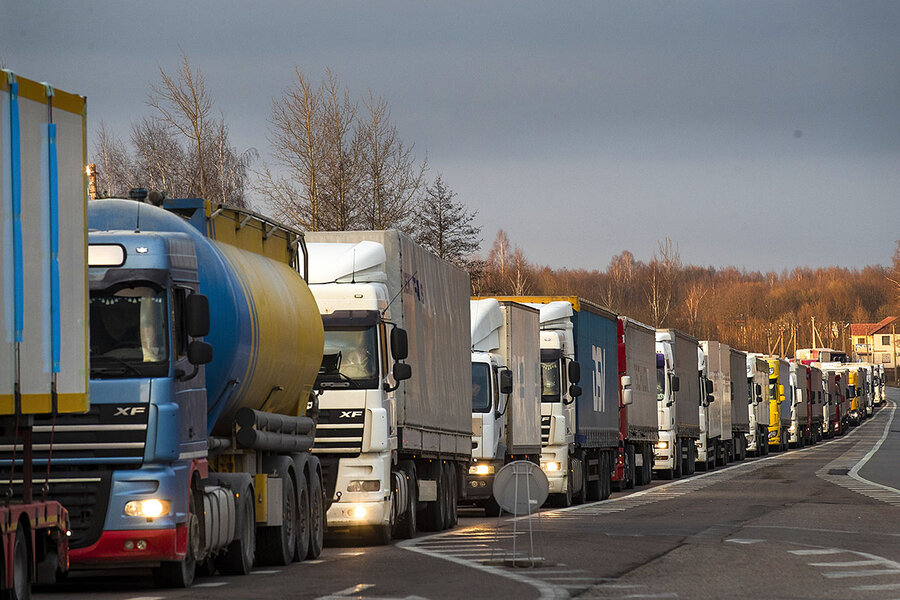Coronavirus tests global sense of who wins: ‘me’ or ‘us’
Loading...
| London
It’s an age-old choice: between “me” and “us.” And so far on the global stage, nationalism – “me” – is winning.
The European Union’s COVID-19 reckoning is especially telling, because the EU should have been singularly well placed to mount a transnational response. When the pandemic struck Italy, Spain, and France hard, however, several member states tightened or closed borders. Some briefly banned exports to the worst-hit areas.
Why We Wrote This
Responses to the pandemic point to a key challenge that lies ahead: whether the increasingly fragile architecture of political alliances, trade partnerships, and the global economic system will be built back to anything like its former self.
Then there’s the huge economic cost of all the shutdowns. Last week strained the EU to the breaking point as Italy and Spain argued for borrowing as a single bloc, taking advantage of northern states’ more solid credit rating, and rebuilding as a single bloc. Northern states demurred. The issue was finessed by a $550 billion package of EU support payments.
The COVID-19 crisis has seen “me” triumph over “us” elsewhere as well. Countries have competed for supplies and restricted related exports, while efforts to coordinate an international response have foundered. The main test may lie ahead, as countries decide how to reengage internationally as they rebuild their economies. One issue may determine how they move forward: relations with China.
This past week, the 27-nation European Union came close to a breaking point. And while it managed to stave off the danger for now, its crisis has dramatically highlighted a key challenge from COVID-19 for national governments around the world.
It is forcing them to make an age-old human choice: between “me” and “us.”
For individuals, that means balancing personal needs with those of other people in the communities, societies, countries, and world of which we’re all a part. For governments, not just in Europe but elsewhere, the spread of COVID-19 has meant choosing between their national interests and a broader international engagement to confront a virus that holds no passport and recognizes no borders.
Why We Wrote This
Responses to the pandemic point to a key challenge that lies ahead: whether the increasingly fragile architecture of political alliances, trade partnerships, and the global economic system will be built back to anything like its former self.
So far at least, nationalism – “me” – is winning.
Editor’s note: As a public service, all our coronavirus coverage is free. No paywall.
And one major question, when the crisis has finally passed, will be whether the increasingly fragile architecture of existing international relationships – political alliances, trade partnerships, and the global economic system as a whole – can or will be built back to anything like its former self. That’s likely to take on even greater importance with recent signs that China, the initial source of the coronavirus, does have a coherent and assertive international strategy for a post-pandemic world.
The EU’s COVID-19 reckoning is especially telling, because the EU should have been singularly well placed to mount a transnational response when the pandemic started hitting member states early this year.
The EU began life as a trading partnership. Yet in recent decades, it has become a fully fledged single market, with a shared passport, a shared currency, and an explicitly stated aim of achieving a similar level of political integration. The official phrase is “ever-closer union,” implying a kind of United States of Europe.
COVID-19 has put that vision to an unprecedented test.
The immediate response in February and early March as the pandemic struck with particular force in three member states – Italy, Spain, and France – was hardly an example of ever-closer union. A number of states tightened or closed their borders. With pressure to ensure adequate supplies of equipment, some EU states also briefly banned exports to the worst-hit areas in Italy or Spain.
Some of this was simply a gut public-health reaction to the sudden spread of the virus. But the real fault line inside the EU – and the cause of last week’s crisis – involves what might be called the second pandemic: the huge economic cost of the shutdowns being used to stem the spread of COVID-19. It essentially pits Germany and other wealthy, fiscally conservative states in northern Europe against more heavily indebted countries of the south.
The aftermath is going to require similarly huge government expenditure, and ultimately borrowing. Since two of the countries most severely hit, Italy and Spain, are already heavily indebted, the argument they’ve been making is for the EU truly to act like a union: to use the northern states’ more solid credit rating as ballast, and to borrow as a single bloc to rebuild as a single bloc, by issuing so called EU coronabonds.
But Germany, Austria, The Netherlands, Finland, and other northern states wanted no part of an arrangement linking their finances to what they view as a fiscally imprudent south. The issue was finally finessed by a $550 billion package of EU support payments. But the coronabond issue remains on the table, to be considered by the heads of government against the background of a warning from Italian Prime Minister Giuseppe Conte that it represented a “challenge to the existence” of the EU.
Beyond Europe
The COVID-19 crisis has seen “me” triumph over “us” elsewhere in the world as well.
Not only have borders been closed and transport links severed. Just as within the EU, countries large and small have been scouring worldwide for supplies of ventilators and other items while seeking to restrict the export of such equipment available domestically.
So far at least, efforts to coordinate a concerted international response have foundered.
A recent conference-call meeting of the Group of Seven, the world’s leading economies, failed even to issue a joint statement, due to objections over a U.S. insistence that it include a reference to COVID-19 as the “Wuhan virus.” U.S. President Donald Trump has also retreated from past administrations’ leadership role in containing international health crises, disregarding calls for the creation of an international task force. This week, he announced plans for the U.S., the principal donor to the World Health Organization, to suspend its funding.
There does seem to be a growing recognition among other G-7 members – the major European states, Canada, and Japan – of the potentially enormous threat the pandemic still poses to less developed nations and refugee populations. Britain, for instance, has announced additional funding for international relief organizations and for WHO.
Still, the main me-versus-us test may lie ahead, as countries decide whether, or to what degree, to reengage internationally as they cope with the inevitable challenge of rebuilding their domestic economies.
Both politically and economically, there have been signs that one issue above all may determine which way they move: relations with China.
Economically, the scramble for equipment to deal with COVID-19 has underscored the degree to which China has become an indispensable part of the global supply chain, not just for consumer products or manufacturing components but countless other products – including critical ventilators and protective equipment.
Politically, that’s become part of China’s own strategy to burnish its image and maximize its influence as the pandemic spreads more widely. In recent weeks, it has made high-profile deliveries to a number of areas in need of supplies, including Italy, Canada, Britain, and New York state in the U.S.
At the same time, it has been reframing the narrative around COVID-19 – a virus whose existence it at first hid from view, and whose origins and extent it has so far chosen not to share in full detail. Instead, Beijing is now trumpeting its success in containing the spread within China, in clear contrast to the response of badly stretched health systems in Western democracies like the U.S. and a number of EU member states.
Editor’s note: As a public service, all our coronavirus coverage is free. No paywall.








